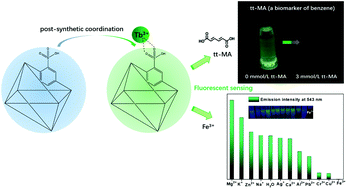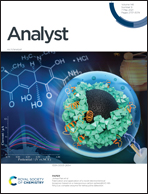Covalent-coordination tandem functionalization of a metal–organic framework (UiO-66) as a hybrid probe for luminescence detection of trans,trans-muconic acid as a biomarker of benzene and Fe3+†
Abstract
By means of post-synthetic treatment on the UiO-66 derivative with –SO3H, a novel luminescent hybrid material named Tb3+@UiO-66–SO3H has been prepared simply and efficiently. Given its wonderful luminescence properties like intense green emission, a long lifetime, a robust structure and photostability, it is further developed as a fluorescent probe for the sensing of trans,trans-muconic acid (tt-MA, a biomarker of benzene) and Fe3+, which are closely related to human health. Notably, Tb3+@UiO-66–SO3H shows an outstanding recognition ability for Fe3+ among common cations with a low detection limit (0.11 μM, 0.006 ppm). More importantly, Tb3+@UiO-66–SO3H can realize highly sensitive and selective detection of tt-MA (detection limit, 0.58 μM, 0.083 ppm). Besides, this rapid response probe is facilely prepared, non-toxic and reusable, showing the potential of Tb3+@UiO-66–SO3H in the practical monitoring of tt-MA and Fe3+.



 Please wait while we load your content...
Please wait while we load your content...